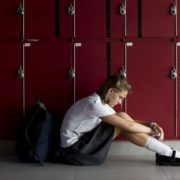What I am about to say will be quite controversial so I would like to declare up front what I am NOT saying. I am not saying that teachers, school officials or administrators, school owners or school boards themselves actively promote bullying or are secretly in favor of bullying. Though I am not discounting the fact that some of these people can themselves be the biggest bullies of all. But in general, I will readily assert that most of these people are good and kind-hearted and only want the best for our kids.
What I am asserting when I say that schools promote bullying is that the traditional SYSTEM of schooling itself provides the structure and breeding ground of bullying, REGARDLESS of the desires or intentions of those who run the system.
Dr. Peter Gray, a research professor at the Department of Psychology of Boston College, names at least 3 structural elements in school that promotes bullying (in the book Free to Learn):
- Grading/Ranking
- Age Segregation
- Lack of Free Play
Top Ten, Honor Roll, Honors’ Class, Valedictorian, Salutatorian, Gold Medal — from the time children start school all the way until they are of legal age, these terms ingrain upon their minds that school is ultimately a place for competition. Since the highest honor in most schools is to be the valedictorian, the implication is for each student to look out for himself or herself rather than to help others. Cooperation is not the highest goal, not if it means sacrificing one’s grade.
In the words of Dr. Gray, “By design, it teaches selfishness…Indeed, too much help given by one student to another is cheating. Helping others may even hurt the helper…Some of those students who most strongly buy into school understand this well; they become ruthless achievers, more interested in beating others than in helping them.”
Again, and I cannot stress this enough, it is the design, the system itself that teaches selfishness. I am certainly not saying that teachers teach selfishness, but that the structure itself rewards selfishness — and kids can see that very early on. They are more perceptive than we think.
Now of course, not everyone can be academic achievers and kids understand this very early on. So they try to find a niche where they can be at the top. They will try to excel in sports, in the arts, or in being the most fashionable, the coolest, the most notorious, the most daring, and so on. And while the latter may not earn them any medals from the school, they earn approval from their peer groups — which they will come to value more than any recognition they get from the school.
So although the school may have a system for ranking the best in academics and even the best in behavior, the students themselves have unconsciously devised a way of ranking themselves in other ways, inspired by the basic idea that life is about ranking and gaining approval even at the expense of others.
The stage is now set for bullying, and the atmosphere is exacerbated by the other two factors.
Part 2
Before schools came along, there was no age segregation. Children were a natural part of the community. They would easily and freely interact with whoever — older kids, younger kids, and even adults. There was no formal distinction made between what a kid ought to be doing vis-a-vis other kids. One kid could be happily playing by herself, another could be helping his dad harvest the potatoes.
In older hunter-gatherer tribes, kids could be tasked with adult responsibilities like climbing trees for fruits or setting traps or even hunting wild animals — as long as they could show that they were up to the task. Age was not so much a factor as was ability and interest. A teenager may not be strong enough to bend a bow but may show an aptitude for plants and can assist the tribe herbalist in creating potions and medicines.
With mass schooling came the idea to group children together in batches, according to their age, and then expecting them to learn the same things at the same time. This was a novel idea and proved to be very efficient — much like mass production in factories. Children were yanked from the playgrounds, from the fields, and from whatever nook and cranny they were hiding in, and placed in neat little rows of desks listening to an adult delivering lectures on history, mathematics, science, and whatever else adults thought was important for the kids to learn.
Now, because of grades and the ranking system (discussed in part 1), the survival instinct to excel and be number 1 becomes more pronounced with batching. Kids were now being forcibly compared with others of their same age. “Hey, the neighbor’s boy can read already at age 7. You’re almost 8. Why can’t you read yet?”
So here people are labeled as “bright”or “dumb” and no matter how much we lecture on political correctness or tell people that kids have multiple intelligences and may develop in different degrees and speeds, the system itself makes us still use those two labels, even if only in our heads — because we are too polite or ashamed to say them out loud.
Even in play and sports, age segregation has a negative effect. Studies have shown that mixed-age play triggers the nurturing instincts of older children. At Sudbury Valley School, for example, where there is unrestricted age-mixing — a game of basketball could be played by a mixed group of teenagers and 8 year olds. The interesting thing one would notice is that the kids will naturally form opposing teams that would more or less have the same number of teenagers and 8 year olds. The teenagers would not group themselves together and say, hey, let’s pound those 8 year olds.
Even during the game, the teenagers would bump and shove against other teenagers but they would not be rough towards or even guard the 8 year olds — leaving the other 8 year olds on their team to deal with them. This allows the younger kids to learn and enjoy the game.
The same principle could hold true for any other endeavor. Kids like learning from older kids because they are, in general, contextually more in tune with them than adults. And older kids enjoy a sense of accomplishment when they are able to help younger kids.
This dynamic is lost in age-segregated schools. No matter how much we lecture on bullying, how to prevent bullying, and so on, the problem persists and gets even worse because we haven’t changed the system.
Dr. Peter Gray, in his book Free to Learn, says, “The age-segregated, competitive atmosphere of school…provides the ideal conditions for the generation of competitive coalitions, or cliques, which provide a foundation for bullying. Children who are not accepted into any of the prevailing cliques may be picked on mercilessly, and they have no way to escape.”
Part 3
Adults often underestimate the value of play. They look at it as merely recreation, a break from the serious stuff, a way to de-stress from work. Take a look at how school is structured and you will see that very little time is devoted to play. 15 minutes of recess in the morning and then another in the afternoon. The rest is devoted to work.
Class activities that include games don’t count. Playing according to a teacher’s rules, without the option to not play, is not really play. It is still work. The child is not playing because they want to, but because an adult said so, and disobedience can have serious consequences.
Real play is about freedom — doing what one wants instead of what one has been told to do, and along with that is also the freedom to quit when one doesn’t want to play anymore, or to do something else. Playing, then is not just about the activity, but one’s state of mind in doing certain tasks.
When I write these articles, I am playing. It is something I want to do, and something I have immense fun in doing. That doesn’t mean I write gibberish and nonsense. I even induce pressure on myself by always writing in the early hours of the morning before the deadline. Does that contribute to my stress levels? Certainly not. I have fun beating the deadline this way and I’ve been doing it week after week for more than 6 years.
The benefits of play are enormous. A study published in 2002 by Howard-Jones, Taylor and Sutton on The Effect of Play on the Creativity of Young Children During Subsequent Activity found that children who were put in a playful mood 25 minutes before engaging them to create picture collages were assessed to have more creative outputs than those who were conditioned to do serious work (like copying text) before the actual task.
Other researchers have created similar studies, all showing that a playful mood results in creative, insightful and out-of-the-box problem solving.
Dr. Peter Gray writes, “Learning, creativity, and problem solving are facilitated by anything that promotes a playful state of mind, and they are inhibited by evaluation, expectation of rewards, or anything else that destroys a playful state of mind.”
So let’s go back to the title of this piece. What does all this have to do with how schools promote bullying?
By the act of forcing children into age-segregated classrooms; restricting their free play; coercing them to listen to lectures they may or may not be interested in, and then evaluating and judging them based on those; by hinging their self-worth on grades, promotion to the next level, commendations and medals; by imposing arbitrary rules on things like haircut, uniforms and the kind of shoes one ought to wear; by the explicit or implicit glorification of the sciences over the arts; by all these and more, the school system, and those who perpetuate it are the biggest bullies of all.
Part 4
A problem that is systemic in nature cannot be solved by good intentions, high ideals or hard work. A teacher who sees the problem and tries to remedy the situation might get away with small changes here and there, but those don’t really do much. Sooner or later, she is going to come up against a principal who will tell her to not rock the boat too much, to follow the system, or else.
A principal radical enough to allow teachers certain freedoms will sooner or later come up against a district supervisor, or the government’s Department of Education (DepEd) telling him to stand down, or else. The system is more likely to swallow individuals than have individuals change it. Those in their comfortable seats of power rarely want to do anything that might jeopardize their position, and of course people with new and interesting ideas would more often be seen as a threat and a potential rival, rather than as a welcome guest.
This is what Dan Greenberg saw when he decided to start Sudbury Valley School. This is what Ken Danford and Joshua Hornick realized when he decided to start the North Star Center for Self-Directed Learning. This is what Tomis Parker and Arthur Brock realized when they started Agile Learning Centers. Change cannot come from within the system. It is too huge, too political, too entrenched for any individual to really do anything about them.
Let me share a couple of anecdotes. My eldest daughter homeschooled her senior high year. Last year, we went to DepEd asking about their placement test for homeschoolers. This test was supposed to be a diagnostic exam that would determine the equivalent grade level of the student on the K-12 system. Guess what we found out — there was no such test in place for grade 12. This was in 2018, seven years after K-12 was first implemented. I wonder what DepEd has been doing all these years.
Here’s another encounter that I had. Since we had plans to open a school, we went to DepEd early this year to get a list of the requirements. The first thing we were told was that we had to submit everything by August 2019 and the earliest we could open was by 2021. I mean, really? It takes them 2 years to approve? And included in the list of requirements is the school building, facilities, and even a full roster of faculty — all of which will supposedly sit and twiddle their thumbs for 2 years waiting for approval.
I mean, really, this is the agency that’s going to accredit my school and determine if it is up to standard? No thanks. And if you want to understand bullying on a large-scale systemic level, you need look no further than this.
—
Reposted with permission. Original series of articles were published on Andy Uyboco’s blog Freethinking Me.










